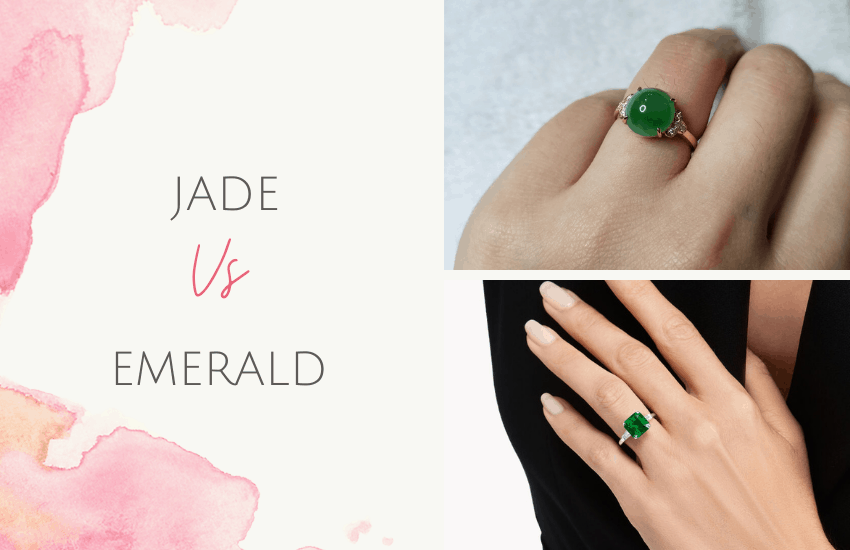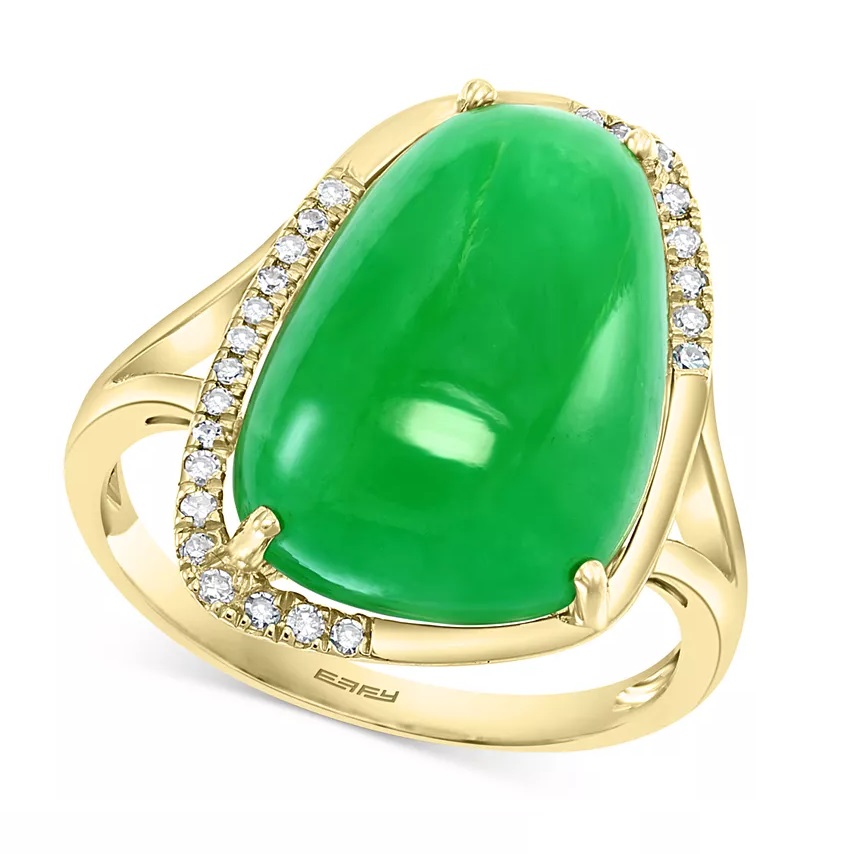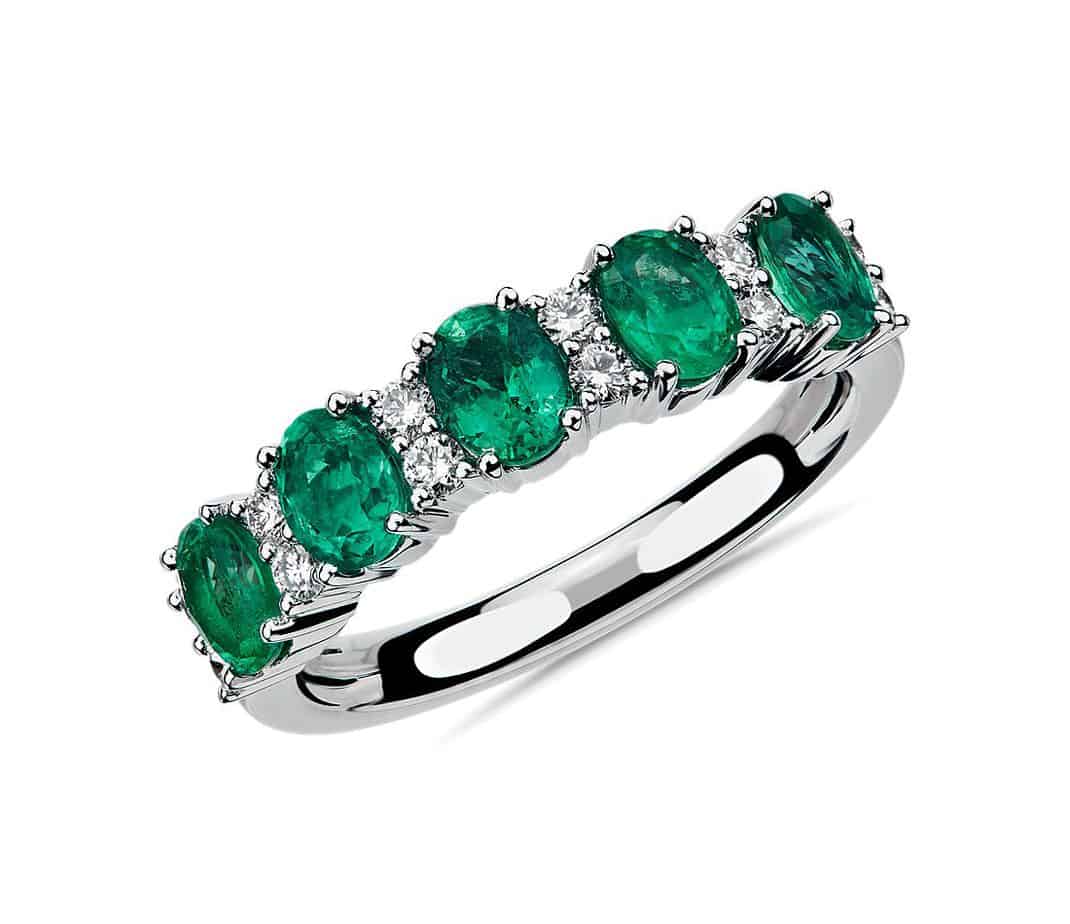- Zola vs MyRegistry: Which is the Best Registry for 2024? - November 30, 2023
- Best Art Deco Wedding Band Ideas - April 23, 2023
- Jade vs Emerald: Which Green Gemstone Is the One for You? - April 23, 2023
Green is a versatile color, especially when it comes to gemstones. As a shade, green is known for calming, tranquility, and putting us in touch with nature’s force and mystery. A large variety of stones share this coloration. However, in this review, we’re comparing two of the finest green stones: Jade vs Emerald. Join us as we examine the makeup, history, uses, and value of these two rare and expensive green stones.
There are lots to cover, so let’s get started.
Main Differences Between Jade vs Emerald
The main differences between Jade vs Emerald are:
- Emerald is a gemstone, whereas jade is an ornamental mineral.
- Jade can refer to two different minerals: nephrite or jadeite, whereas an emerald is one specific variety of transparent green minerals, beryl.
- Emerald is a lot more valuable, whereas jade is sold for less.
- Emerald breaks much more easily, whereas jade has much more resistance.
Jade vs. Emerald: Their Core Similarities:
- Both jade vs emerald showcase green hues, although jade can also lean towards whiter shades.
- Both stones are used for ornamental and jewelry-making purposes
- Jade vs emerald both get their green coloration from traces of chromium.
- Both jade vs emerald are often cut into a cabochon shape when used in jewelry.
About Jade
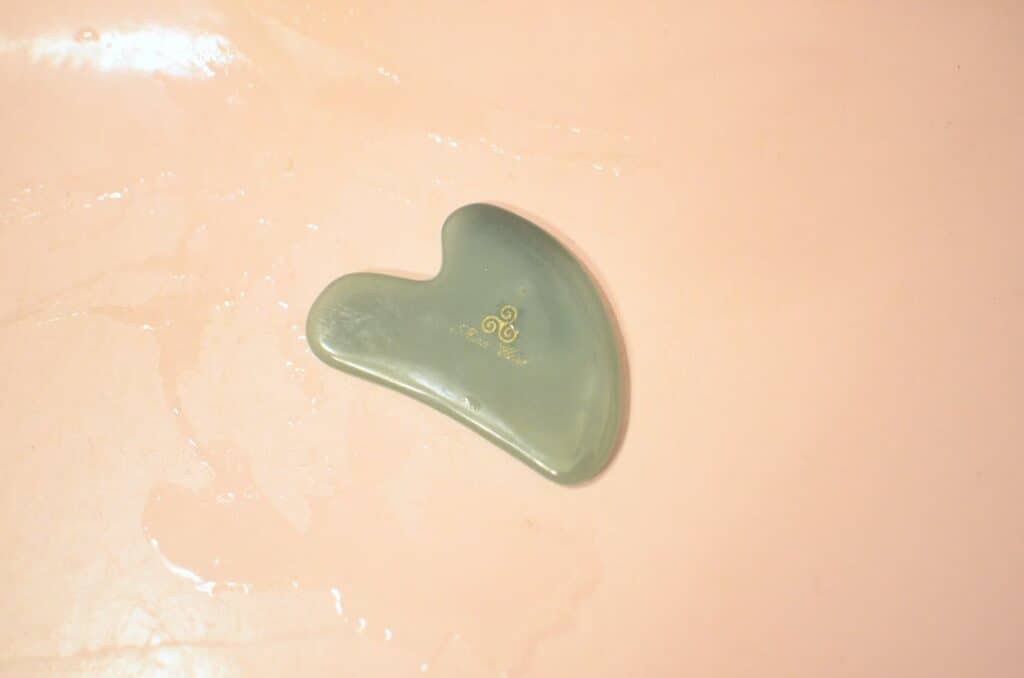
As we’ve already hinted at, jade is an ornamental mineral known for its green coloring. While it can adopt deep green hues, it also often features yellow and white colorations.
Jade can refer to one of two different silicate minerals:
- Nephrite (a silicate of magnesium and calcium)
- Jadeite (a silicate of sodium and aluminum)
The higher the iron content in jade, the greener the color. Jadeite is the more valuable of the two silicate minerals. It only occurs in metamorphic rocks, making it a pretty rare find!
Due to the smooth surface and high durability of jade, the stone has been used for hardstone carving. It’s as hard as quartz, with a hardness rating between 6.0 and 7.0 on the Mohs hardness scale.
We simply can't get enough of the beautiful tones of Jade Jewelry. Find the latest trends, styles and deals with free shipping or curbside pickup available.
About Emerald

Emerald is a green and slightly transparent variant of the mineral beryl. Its blueish green hues are created by the trace amounts of chromium and vanadium in its composition.
This stone’s coloration is unmatched and will only make its competitors green with envy! After all, it’s one of the most sought-after gemstones on the market. Emerald consistently surpasses other transparent variants like peridot.
Alongside ruby, sapphire, and diamond, emeralds are one of the four recognized precious gemstones. As such, considerable value is attached to them.
They’re most commonly found in Columbia. In fact, Columbia is responsible for more than 50% of emerald production worldwide!
Emerald’s hardness score sits between 7.5 and eight on the Mohs scale. That said, they’re pretty robust to breakage.
The beautiful deep tones of green from these stunning Emeralds might be just the answer to upgrade any look.
Jade vs. Emerald: A Brief History of Green Stones
Before we dive into modern applications, prices, and both stones’ advantages, let us look at how they feature in our history:
Jade
Jade has a long history in craftsmanship and ritual around the world. It appears most commonly in art and sculptures from East Asia, where jade was an imperial gem. Variants of jade were mined as early as 6000BC in China!
The gem was used to create a large variety of ceremonial or ornamental objects, including burial suits made entirely out of jade. It was also used as a favored crafting material for scholarly things such as calligraphy brush rests and pipe mouthpieces.
In China’s art history, the importance of jade can be likened to gold in the west. The use of jade, however, was also a long-term tradition in prehistoric and historical Korea. On top of that, jade is also the national stone of Japan.
Notably, jade also features in various other cultures, such as the Maori of New Zealand. They crafted jade into heirloom necklaces and used it for rituals to contact ancestral spirits.
Emerald
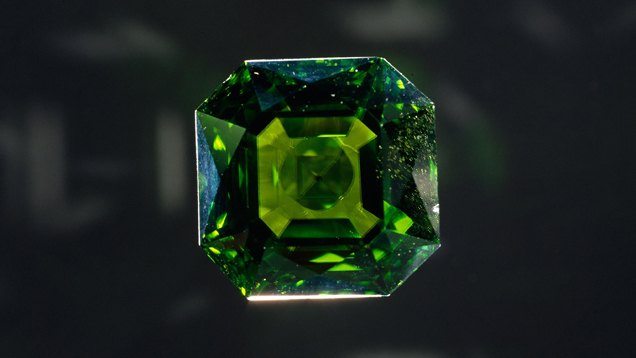
Emeralds were mined in Egypt as early as 1500 BCE and in India and Austria since the 14th century CE. These mines were later exploited on an industrial scale by the Roman and Byzantine Empires.
When Columbian deposits were discovered, the mining ceased. Columbia now remains one of the largest producers of emeralds globally. The second-biggest producer is Zambia, with large deposits found near the Kafubu River.
But aside from these locations, emeralds can be found worldwide in France, Germany, India, Australia, Brazil, China – just to name a few!
Synthetic emeralds have been on the market since 1964. These are developed by producing an emerald overgrowth on colorless beryl. Later on, completely synthetic emeralds were produced by hydrothermal synthesis.
What can and can’t be classified as a synthetic stone is decided by the U.S Federal Trade Commission, which has strict regulations on presenting a fair and transparent image to consumers. Synthetic emeralds can be labeled as “created” due to their close chemical and gemological resemblance to the natural stone.
Jade vs. Emerald: Symbolism
Many love the appeal of birthstones and how colors represent their favored traits. If you’re curious how jade vs emerald are perceived, you’ll find noteworthy symbolism here:
Emerald
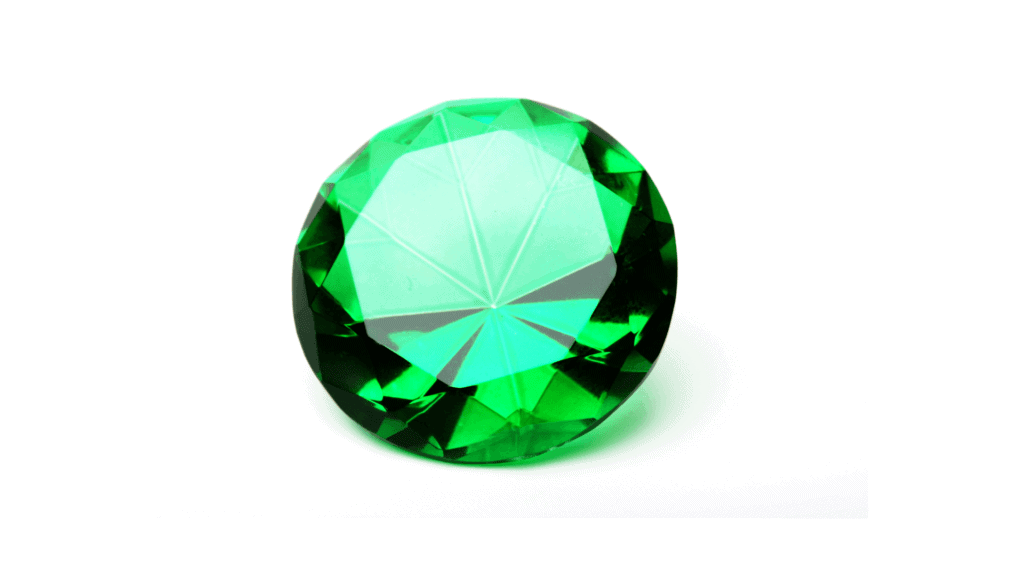
Emeralds, due to their value and rarity, are associated with royalty and wealth. But they also encompass wit, foresight, and eloquence. Emerald is nicknamed the “Jewel of Kings” and often represents May’s birthstone. Emeralds also exuberate mysticism and beauty.
Throughout history, emeralds have been linked with mysterious cities. Western cultures will most likely remember the Emerald City in “The Wizard of Oz.” However, fabulously wealthy cities constructed from precious stones are also present in ancient Indian tales; here, emeralds would drip from plants.
Jade
Like emerald, jade is associated with nobility and wealth – especially in the far east. Jade has been revered in China for centuries. In fact, one of the great gates to the world-famous wall of china is named the Jade gate. Chinese artisans worked the stones into monumental sculptures and ornaments, earning jade the title of “Yu,” the “jewel of heaven.”
Jade has also had a close connection with mysticism and religion throughout history. Most notably, the Maori people of New Zealand fashioned jade into cherished heirloom pendants that helped them seek guidance from ancestral spirits.
Due to the stone’s durability, ancient stoneworkers appreciated the rock’s smooth feel, durability, and soft clink. It’s no surprise that jade has hence been associated most commonly with harmony and eternity.
Jade vs Emerald: Shapes and Treatment
Both the value and appearance of gemstones are influenced dramatically by how they’re cut and shaped. Their treatment can also affect the price. In light of that, we’re going to explore the cuts, shapes, and treatments that apply to jade vs emerald in more depth below:
Emerald
First off, let’s look at the shapes and cuts you can create with emerald:
Shapes and Cuts
It’s common for emeralds to include non-uniform colorations and motives. So, there might be secondary hues or combinations of blue and yellow within the stone, which is why emeralds are often cut in a cabochon form rather than faceted shapes.
With the cabochon cut, transitions in hue are less noticeable and add character to the smoothly shaped stone. Whereas, with sharper edges, the differences in coloration would disrupt otherwise even surfaces.
When emeralds are cut to include facets, they’re commonly given an oval or the signature emerald cut, which is rectangular with facets around the top edge.
Treatment

As emeralds are softer than other gemstones, most stones have surface-reaching cracks filled with oils as part of the post-lapidary process. This improves the stone’s stability and clarity.
Cedar oil is most commonly used due to its similar refractive index to emerald. But the use of synthetic oils and polymers with close refractive indexes isn’t uncommon.
The treatments are usually applied in a vacuum chamber under mild heat. This opens the stone’s pores so that the agent can be absorbed effectively. The stone’s treatment has to be disclosed when an emerald is sold under the U.S federal trade commission, so be sure to look out for that!
Jade
Now, let’s turn our attention to jade and its most commonly used shapes and cuts:
Shapes and Cuts
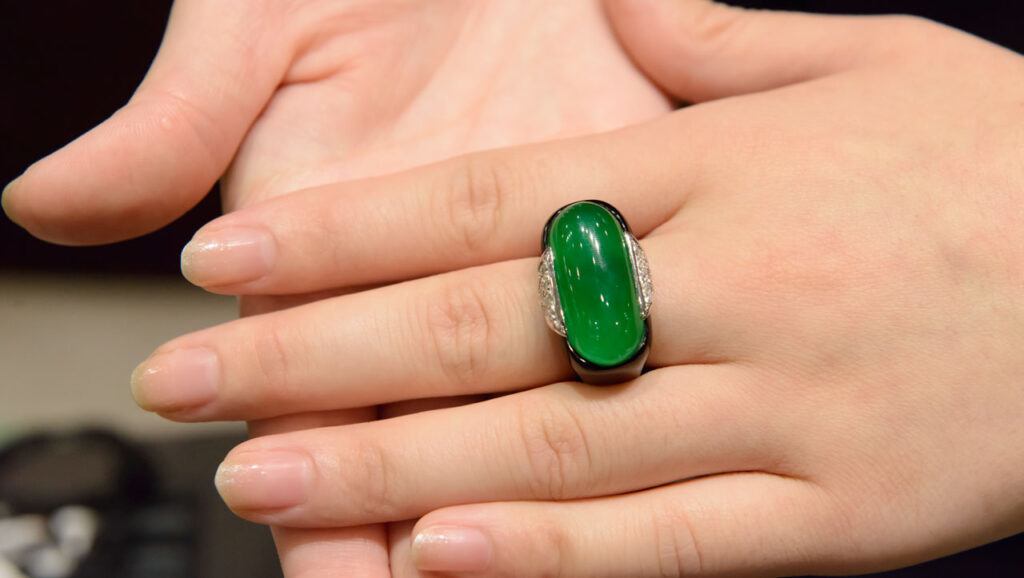
Due to jade’s versatility and durability, it can be cut and carved into all manner of shapes. This is why entire bracelets and rings can be composed out of 100% jade. It’s also why craftspeople can create elaborate forms, pendants, and sculptures using this stone.
The highest quality jade is vibrant in color, translucent, and smooth. This is usually cut into cabochons and set into jewelry. It’s also often carved into beads for bracelets, necklaces, and earrings.
Treatments
Jade can be enhanced and treated in several ways. A type B jade is bleached to remove the stone’s oxidation stains or impurities. This lightens its color but can make the stone more porous and prone to breaking.
To fix this, a polymer resin is used to create a more polished and lustrous look. However, over time, stones donning this treatment can discolor and turn yellowish when exposed to heat and sunlight.
Type C jade undergoes further treatment than the steps above. They’re also dyed to enhance the color. These stones can’t be used for long as their color fades over time. As such, stones with this treatment aren’t as valuable.
Jade vs. Emerald: How Their Value is Determined
If you’re looking to buy an heirloom piece, you’ll most likely want to know how the value of your rock is determined. Let’s find out:
Emerald

Emerald is recognized as one of four precious gemstones, along with sapphires, rubies, and diamonds. These gemstones are graded by four parameters: color, clarity, cut, and carat weight. All of these elements influence the price of each individual stone.
In general, emerald is more expensive to set than jade due to its low breaking point. Emerald isn’t very hard, which makes putting them into jewelry much more precarious.
Luckily for the emerald, its color is its selling point, followed by its clarity. Unlike diamonds, the clarity of an emerald is graded by the eye. If there aren’t any visible inclusions, it’s considered flawless. It’s extremely rare to find an emerald without surface-breaking fissures, which is why emeralds are generally treated with oils to fill the surface.
The highest prices are commanded by emeralds with fewer than 15% of secondary hues. On the other hand, the most popular coloration is a 75% tone, as 100% would be an opaque black. The most popular (and expensive) emeralds have very saturated colors and display a vibrant green hue.
A great alternative, Brilliant Earth offers natural as well as lab-grown Emerald gemstones and jewelry.
Jade
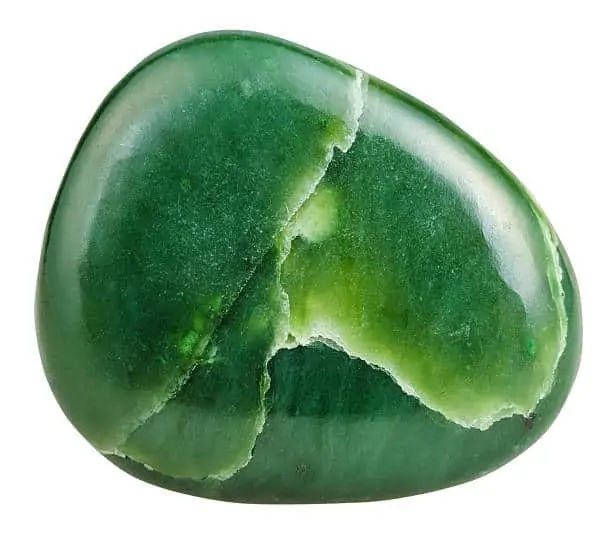
Unlike other gemstones, the price of jade isn’t measured by weight because it’s heavier and denser than other stones. The stone is therefore measured in millimeters instead of carats.
Another factor determining the value of jade is translucency, i.e., how much light can pass through the gem. The higher this value, the more valuable the jade is.
Clarity and texture are other elements worthy of consideration, with higher value jade being exceptionally smooth and delicate. The vibrancy of the color can also influence the price. The more vibrant and consistent the color under different lights, the more expensive the stone may be. Unsurprisingly, pure green is the most prized variety.
We simply can't get enough of the beautiful tones of Jade Jewelry. Find the latest trends, styles and deals with free shipping or curbside pickup available.
Jade vs. Emerald: Which is More Expensive?
The price of jade and emeralds depends very heavily on the factors discussed above. Depending on the cut, color, weight (or size), and clarity, you might be looking at a more or less expensive stone.
But generally speaking, emerald is more expensive than jade. Namely, because it’s classified as a precious gem and boasts rare vibrancy and clarity. However, this doesn’t mean jade is cheaper by default.
The price of jade can vary to suit any budget. However, jade’s cost and demand are driven heavily by the Chinese market, where jade is still very popular and fetches a high price. As such, at the top end of the market, jade stones can be worth more than gold! With rising demands in the east, the price of jade has grown exponentially.
Jade vs. Emerald: Pros and Cons
We’ve thrown quite a bit of information at you, so let’s try and condense this comparison to just the headlines. To help do exactly that we’ve compiled a quick pro-cons list for both emerald and jade:
Emerald
Gem-quality beryl and emeralds are used most commonly in the jewelry trade. They’re fabulous for decorating rings and make fantastic pendants. With this use in mind, here are the benefits and drawbacks of emerald:
The Pros:
- Emeralds are often cheaper than diamonds, making them an affordable option for a non-traditional engagement ring
- Their vivid green coloration makes a rare impression
- As precious gemstones, emeralds hold their value
- Due to their clarity and coloration, emeralds can appear larger than they actually are.
The Cons:
- Emerald isn’t as durable as other precious gems. It’s more brittle and prone to fracturing, making it unsuitable for frequently worn jewelry.
- Due to their strength, emeralds need hand cleaning with warm water rather than an ultrasonic machine.
- Emeralds can be heavily included. This is technically an imperfection in the stone. This may be an aesthetic you like, or it might be a drawback for you.
Jade
Jade has a variety of applications. It’s still used today for creating ornaments and jewelry. But, in more recent times, jade is used to make beauty tools like face rollers and therapy stones. It warms when in contact with the skin and is soothing with its smooth surface feel.
We’ll also evaluate jade’s pros and cons as a gemstone for jewelry for the fairest comparison.
The Pros:
- Jade can be fashioned into all sorts of versatile shapes, so you can create interesting-looking pendants that sit warm against your skin. They can also be used for bracelets that feel equally smooth and comforting, or you can have engagement rings carved entirely out of jade.
- The versatility of jade allows you to craft several ring styles and designs.
- Jade’s different colorations complement a wide array of complexions and skin tones.
- Jade is available for every budget.
The Cons:
- At least in the west, jade doesn’t have the same traditional appeal that other precious gemstones have.
- Jade doesn’t have high clarity, which means it doesn’t appear as luminescent or valuable.
- Due to the lack of luminescence, jade doesn’t suit faceted stone cuts as well emeralds do.
FAQs about Green Stones
Question: How should I clean my jade ring?
Answer: Jade is highly durable but requires care to maintain its shine. Regular cleaning will keep it in good condition. But, never use chemical cleaners on your jade jewelry, and don’t expose it to heat. Instead, wipe it with a cloth using lukewarm water with a few drops of liquid soap. Avoid using jewelry cleaning solutions as they may damage the stone.
Question: How do I clean emerald jewelry?
Answer: You should clean emeralds gently, using a warm, mild detergent solution and a soft brush. A worn-out toothbrush is one option. You can soak the emerald in a dishwashing detergent first.
Then, rinse the emerald with warm water, and pat it dry. Don’t leave the stone submerged in the cleaning solution for longer than necessary, and don’t clean it with ultrasonic cleaners. After several years, you can get your emerald re-oiled, which is a service offered by most jewelers.
Question: Is jade a precious stone?
Answer: Jade is only a semi-precious stone, which is why it’s often cheaper than emeralds. It consists of fibrous crystals that interlock in a matte texture and isn’t generally as vibrant or luminescent as emerald.
Question: Is emerald or jade better for an engagement ring?
Answer: Whether you prefer emerald or jade for an engagement ring depends on your personal preferences. Both are less traditional options than diamond, and both exude eye-catching green hues. But, ultimately, emerald is more luxurious and vibrant. In contrast, jade is more resilient and versatile – so it’s swings and roundabouts.
Question: Is emerald a birthstone?
Answer: Emerald is the birthstone of May. A fitting association, given the vivid spring radiance of its green color.
Question: Is jade a birthstone?
Answer: Jade is one of the birthstones for August and March.
Question: How can I recognize a synthetic emerald; what are its qualities?
Answer: To identify a synthetic emerald, look for a slightly rounded facet edge or a somewhat dimpled surface that can be observed under magnification.
Other than that, lab-created emeralds have the exact same mineral makeup as natural emeralds. But because they don’t show Jardin, they’re often more durable than actual emeralds.
Jade vs. Emerald: Our Final Thoughts
Both jade and emerald are fascinating stones with a long cultural history full of ritual, royalty, and mysticism. Suppose you’re considering a green-colored stone for an engagement ring or any other piece of jewelry, for that matter.
In that case, you’ll find a beautiful statement piece with either. Emeralds ensure vibrant coloring and pure elegance, whereas jade maintains a feeling of harmony, peace, and resilience.
Which gemstone calls out to you? Let us know in the comments box below whether jade or emerald have caught your interest.
The beautiful deep tones of green from these stunning Emeralds might be just the answer to upgrade any look.
